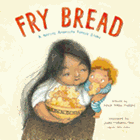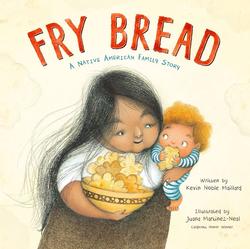
 While Fry Bread: A Native American Family Story is recommended for audiences ages three to six, it's undoubtedly a book that will last on shelves well into readers' double digits. Kevin Noble Maillard--co-editor of Loving v. Virginia in a Post-Racial World, Syracuse University law professor and a member of the Seminole Nation, Mekusukey band--has effectively written two books for multiple age groups.
While Fry Bread: A Native American Family Story is recommended for audiences ages three to six, it's undoubtedly a book that will last on shelves well into readers' double digits. Kevin Noble Maillard--co-editor of Loving v. Virginia in a Post-Racial World, Syracuse University law professor and a member of the Seminole Nation, Mekusukey band--has effectively written two books for multiple age groups.
The first two-thirds is an affecting picture book that features family and friends gathering, creating and enjoying fry bread together. Glorious double-page spreads introduced by pithy, resonating phrases define the Native American staple: "FRY BREAD IS FOOD," "FRY BREAD IS COLOR," "FRY BREAD IS HISTORY." Pura Belpré-awarded illustrator Juana Martinez-Neal's (Alma and How She Got Her Name) artistry revels in the faces: the children's hungry delight at the "light like snow and cream/ Warm like rays and sun" results; the adults' joy in "moments together"; the elders' anguish when forced to explain "the stolen land/ Strangers in our own world/ With unknown food/ We made new recipes/ From what we had." Maillard's text readily convinces that "FRY BREAD IS US," as "we strengthen each other/ To learn, change, and survive."
Then comes book two, which augments the simple, sincere verses with illuminating edification for older readers. The final section begins with "Kevin's Fry Bread" recipe--hinted at in Martinez-Neal's earlier illustration of handwritten notes held by children anticipating the sizzling, golden dough--and graced with both Maillard's likeness as well as what must be a portrait of his "gourmand" Aunt Fannie, who bequeathed Maillard her "culinary, scientific" secrets. Maillard's expansive author's note follows across nine pages, amplifying every descriptive "Fry bread is..." phrase with context, background, history and personal tidbits. "Fry bread is food..." reveals the individual creator of the bowl in which the batter is mixed and the controversies surrounding "right" and "wrong" recipes. "Fry bread is sound..." points to Seminole symbol-tattoos and discusses longstanding health issues in underserved Native communities. "Fry bread is color..." displays the diversity of Native Americans, highlighting the "intermingling between tribes and also with people of European, African, and Asian descent," so that blonde hair or black skin are all part of being Native American. "Fry bread is time..." explains how Maillard became his family's "lady" to inherit the recipe, "gender requirements aside." "Fry bread is history..." provides a sobering overview of Native American dispersion and destruction by the U.S. government--which continues today. "Fry bread is nation..." presents introductory insight into the "573 federally recognized Native American tribes in the United States," with a disturbing reminder of the additional "groups who were not successful in their attempts to achieve official status with the U.S. or state governments"; Maillard insists on inclusive recognition, giving "voice to the Indigenous nations and communities within the United States" by including tribe names across the endpapers. Remarkable in balancing the shared delights of extended family with onerous ancestral legacy, Maillard both celebrates and bears witness to his no-single-recipe-fits-all community. --Terry Hong, Smithsonian BookDragon
Shelf Talker: In Kevin Noble Maillard's debut, the simple act of making Native American Fry Bread becomes a practice of tradition, a celebration of community and the honoring of crucial historical legacy.

